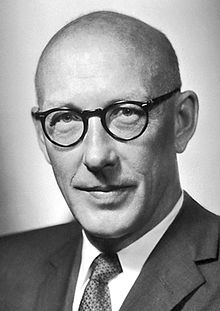Edward Tatum
This article includes a list of references, related reading or external links, but its sources remain unclear because it lacks inline citations. (February 2013) |
Edward Tatum | |
|---|---|
 | |
| Born | Edward Lawrie Tatum December 14, 1909 Boulder, Colorado, United States |
| Died | November 5, 1975 (aged 65) New York City, United States |
| Alma mater | University of Chicago University of Wisconsin–Madison |
| Known for | Gene regulation of biochemical events within cells |
| Awards | Nobel Prize in Physiology or Medicine |
| Scientific career | |
| Fields | Genetics |
| Institutions | Stanford University Yale University Rockefeller Institute |
| Doctoral students | |
| Other notable students | Esther M. Lederberg |
Edward Lawrie Tatum (December 14, 1909 – November 5, 1975) was an American geneticist. He shared half of the Nobel Prize in Physiology or Medicine in 1958 with George Beadle for showing that genes control individual steps in metabolism. The other half of that year's award went to Joshua Lederberg.
Beadle and Tatum's key experiments involved exposing the bread mold Neurospora crassa to x-rays, causing mutations. In a series of experiments, they showed that these mutations caused changes in specific enzymes involved in metabolic pathways. These experiments, published in 1941, led them to propose a direct link between genes and enzymatic reactions, known as the "one gene, one enzyme" hypothesis.
Tatum went on to study genetics in bacteria. An active area of research in his laboratory was to understand the basis of Tryptophan biosynthesis in Escherichia coli. Later, Tatum and his student Joshua Lederberg showed that E. coli could share genetic information through recombination.
Tatum was born in Boulder, Colorado. He attended the college at the University of Chicago for two years,[1] and transferred to the University of Wisconsin–Madison, where he received his BA in 1931 and PhD in 1934.[2] Starting in 1937, he worked at Stanford University, where he began his collaboration with Beadle. He then moved to Yale University in 1945 where he mentored Lederberg. He returned to Stanford in 1948 and then joined the faculty of Rockefeller Institute in 1957. A heavy cigarette smoker, he died in New York City of heart failure complicated by chronic emphysema.
References[]
- ^ McMurray, Emily J.; Kosek, Jane Kelly; Valade, Roger M. (1995). Notable Twentieth-century Scientists: S-Z. Gale Research. p. 1970. ISBN 0810391856.
- ^ "Edward Tatum - Biographical". www.nobelprize.org. Retrieved 2018-03-03.
Further reading[]
- Lederberg, Joshua (1990). "Edward Lawrie Tatum 1909—1975" (PDF). Biographical Memoirs. National Academy Press. 59.
- Nobel Lectures, Physiology or Medicine 1942–1962, Elsevier Publishing Company, Amsterdam, 1964
External links[]
- Edward Tatum on Nobelprize.org

- 1909 births
- Members of the United States National Academy of Sciences
- 1975 deaths
- American geneticists
- American Nobel laureates
- Nobel laureates in Physiology or Medicine
- People from Boulder, Colorado
- Stanford University Department of Biology faculty
- Stanford University School of Medicine faculty
- University of Wisconsin–Madison alumni
- Rockefeller University faculty